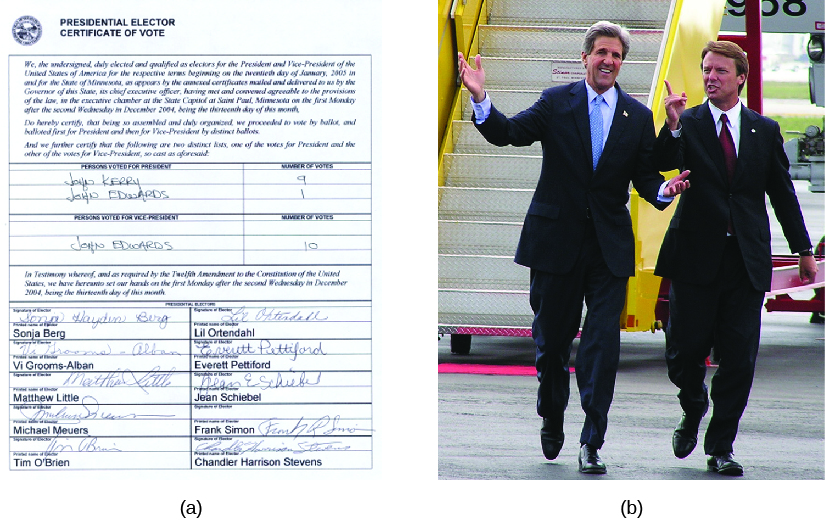| << Chapter < Page | Chapter >> Page > |
The number of Electoral College votes granted to each state equals the total number of representatives and senators that state has in the U.S. Congress or, in the case of Washington, DC, as many electors as it would have if it were a state. The number of representatives may fluctuate based on state population, which is determined every ten years by the U.S. Census, mandated by Article I, Section 2, of the Constitution. For the 2016 and 2020 presidential elections, there are a total of 538 electors in the Electoral College, and a majority of 270 electoral votes is required to win the presidency.
Once the electoral votes have been read by the president of the Senate (i.e., the vice president of the United States) during a special joint session of Congress in January, the presidential candidate who received the majority of electoral votes is officially named president. Should a tie occur, the sitting House of Representatives elects the president, with each state receiving one vote. While this rarely occurs, both the 1800 and the 1824 elections were decided by the House of Representatives. As election night 2016 played out after the polls closed, one such scenario was in play for a tie. However, the states that Hillary Clinton needed to make that tie were lost narrowly to Trump. Had the tie occurred, the Republican House would have likely selected Trump as president anyway.
As political parties became stronger and the Progressive Era’s influence shaped politics from the 1890s to the 1920s, states began to allow state parties rather than legislators to nominate a slate of electors. Electors cannot be elected officials nor can they work for the federal government. Since the Republican and Democratic parties choose faithful party members who have worked hard for their candidates, the modern system decreases the chance they will vote differently from the state’s voters.
There is no guarantee of this, however. Occasionally there are examples of faithless electors . In 2000, the majority of the District of Columbia’s voters cast ballots for Al Gore, and all three electoral votes should have been cast for him. Yet one of the electors cast a blank ballot, denying Gore a precious electoral vote, reportedly to contest the unequal representation of the District in the Electoral College. In 2004, one of the Minnesota electors voted for John Edwards, the vice presidential nominee, to be president ( [link] ) and misspelled the candidate’s last name in the process. Some believe this was a result of confusion rather than a political statement. The electors’ names and votes are publicly available on the electoral certificates, which are scanned and documented by the National Archives and easily available for viewing online.

In forty-eight states and the District of Columbia, the candidate who wins the most votes in November receives all the state’s electoral votes, and only the electors from that party will vote. This is often called the
winner-take-all system . In two states, Nebraska and Maine, the electoral votes are divided. The candidate who wins the state gets two electoral votes, but the winner of each congressional district also receives an electoral vote. In 2008, for example, Republican John McCain won two congressional districts and the majority of the voters across the state of Nebraska, earning him four electoral votes from Nebraska. Obama won in one congressional district and earned one electoral vote from Nebraska.
Presidential elections garner the most attention from the media and political elites. Yet they are not the only important elections. The even-numbered years between presidential years, like 2014 and 2018, are reserved for congressional elections—sometimes referred to as midterm elections because they are in the middle of the president’s term. Midterm elections are held because all members of the House of Representatives and one-third of the senators come up for reelection every two years.
During a presidential election year, members of Congress often experience the coattail effect , which gives members of a popular presidential candidate’s party an increase in popularity and raises their odds of retaining office. During a midterm election year, however, the president’s party often is blamed for the president’s actions or inaction. Representatives and senators from the sitting president’s party are more likely to lose their seats during a midterm election year. Many recent congressional realignments, in which the House or Senate changed from Democratic to Republican control, occurred because of this reverse-coattail effect during midterm elections. The most recent example is the 2010 election, in which control of the House returned to the Republican Party after two years of a Democratic presidency.
The Federal Election Commission was created in an effort to control federal campaign donations and create transparency in campaign finance. Individuals and organizations have contribution limits, and candidates must disclose the source of their funds. However, decisions by the Supreme Court, such as Citizens United , have voided sections of the campaign finance law, and businesses and organizations may now run campaign ads and support candidates for offices. The cases also resulted in the creation of super PACs, which can raise unlimited funds, provided they do not coordinate with candidates’ campaigns.
The first stage in the election cycle is nomination, where parties determine who the party nominee will be. State political parties choose to hold either primaries or caucuses, depending on whether they want a fast and private ballot election or an informal, public caucus. Delegates from the local primaries and caucuses will go to state or national conventions to vote on behalf of local and state voters.
During the general election, candidates debate one another and run campaigns. Election Day is in early November, but the Electoral College formally elects the president mid-December. Congressional incumbents often win or lose seats based on the popularity of their party’s president or presidential candidate.

Notification Switch
Would you like to follow the 'American government' conversation and receive update notifications?